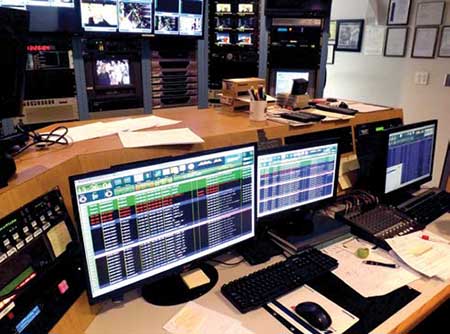Automation Enhances Budgets, Workflows
SAN FRANCISCO—Big or small—whether you’re in rural market 100 or in the nation’s top 10—there are always two tantalizing results that come from revamping a station’s automation capabilities.
The first, most often, is cost.
That was one of the drivers for station WKNO-TV, a PBS station in Memphis, Tenn., that decided to deploy a new automation system earlier this year. Working with NVerzion, WKNO installed a CLASS automation system—also known as the company’s Component Level Automation System Solution—to control third-party equipment such as archiving and traffic systems.
Looking to replace a 10-year-old broadcast automation system with something more efficient and reliable that would pay off in an economic sense, the CLASS platform “offered compatibility with our existing traffic and archive systems,” said Erwin Roman, engineering manager at WKNO. Today the system is handling recording, scheduling, media preparation and ingest operations for the station’s main HD channel and one SD subchannel.
THE BXF PROTOCOL

WKNO in Memphis recently installed an NVerzion CLASS automation system to control third-party equipment such as archiving and traffic systems. Like a number of modern automation systems, the CLASS platform uses the BXF Broadcast eXchange Format, a protocol that standardizes the communication process when exchanging data between two systems. For WKNO, using this interface means that it has been able to fulfill one of its primary goals—lowering operational expenses—as well as improve broadcast presentation quality.
“By using the BXF file format, we were able to help them set up two-way communication to keep traffic and engineering in sync and make changes very easily through a network communications messaging format,” said Reed Haslam, director of sales and marketing for NVerzion, a Salt Lake City-based provider of broadcast automation systems.
Get the TV Tech Newsletter
The professional video industry's #1 source for news, trends and product and tech information. Sign up below.
Cost remains the single most significant driver when it comes to retooling an automation system, said Shawn Maynard, vice president and general manager of Florical Systems in Gainesville, Fla. “Broadcasters are continuing to ask ‘How can I create a viable workflow while spending half or a third of what we’ve spent before,” he said. “The market really is looking for creative and innovative ways of using technology to do more with less.”
Florical is responding with solutions like the FastForward acquisition and distribution platform which it will launch at NAB. According to Maynard, FastForward is a “holistic approach to centralizing and acquiring content” from stations and then distributing it via fiber to any number of locations. Users can acquire, QC and catalog assets and metadata from a centralized location and distribute the material fully location and distribute the material fully prepped.
Where there have been mechanisms for moving content from one location to another, Maynard said this solution allows broadcasters to move both the video and metadata together. “For syndicated programs, you don’t lose your timing, for example,” he said. “You manage it once and it goes end to end.”
That second goal for station’s revamping their automation interface? Improving workflow efficiencies.
Dallas-based Imagine Communications linked forces in 2014 with the Maine Public Broadcasting Network (MPBN), which operates a number of educational radio and television stations as well as a local public TV station. When MPBN began to rebuild its master control operations, it too chose a BXF-compliant traffic and automation system with a file-based design to streamline daily processes. The network installed Imagine Communication’s Live- Update solution, a BXF interface that integrates Myers ProTrack traffic and scheduling software and ADC automation.
THE CLOUD
While BXF is driving the improvement of internal communications, stations are also looking for answers in the cloud—particularly as it relates to workflow improvements. Last year Imagine Communications addressed the issue with the VersioCloud IP-enabled cloud playout platform, a solution that allows media companies to manage video operations and channel playout from within a cloud infrastructure.
The benefits are straightforward: simplifying the creation and management of channels. Cloud-enabled playout functions within VersioCloud include branding, graphics, automation and server capabilities. The solution also includes a software control system and processing and compression solutions that allow for management of hybrid SDI, ASI, and IP content.
NVerzion, also is finding success in the cloud space with CloudNine, a cloud-based automation and media asset management system that enables broadcasters to control, store and monitor high-quality audio and video content.
But it isn’t all rosy up there. While the cloud offers many benefits, it’s not a solvesall- problems solution.
Sometimes stations really do like the ability to do all of their controls locally,” an aspect that is lost when relying on a cloud-only automation scenario, according to Haslam. “The industry is going [the way] of the cloud,” but is still battling around questions about accuracy and security, particularly when it comes to automation.
LINKING SYSTEMS
Giving a single, clear point of control was one aspect that Grass Valley alighted upon when it was developing its Ignite Automated Production system. The system links together control room and newsroom, and allows a single operator to manage control room devices to produce live newscasts and event programming. It repurposes content for digital multicasting and Webcasts, and integrates with production switchers and audio consoles.
Supporting multiple playback formats was a priority for RUSHWORKS, which recently introduced an enhanced version of its broadcast automation system, A-List Broadcast. Since its inception 15 years ago, the Flower Mound, Texas-based company has focused on low-power markets like Meridian, Miss., where the Meridian Broadcasting station group recently purchased two A-LIST systems for WHPM-LD and KJNB-LD. “There are stations that had been traditional standard-definition that are making the move to HD, and [acquired this automation] solution to do just that,” said Rush Beesley, RUSHWORKS founder. The system is cost effective, he said, a requirement in this bumpy broadcast economic market that more stations—not just smaller market ones—are bumping up against
“[Economics is one thing] that has to be taken into account for broadcasting to stay alive,” he said. “With diminishing revenues and the current business model, the days of the big iron systems and big costs are long gone.”
Designed for either Webcast or traditional broadcast stations, the A-List automation and streaming solution offers up to four SD or HD playback channels in a chassis, with live input passthrough and recording, and multiple layers of downstream graphics. Like a number of other solutions on the market, the hybrid A-List supports multiple A/V routing switchers, drag-and-drop playlist creation, traffic and billing import, and router control, and supports real-time up and down conversion between SD and HD files.
Another station that recently refreshed their automation offering is WKBN-TV, a CBS affiliate in Youngstown, Ohio, that upgraded its entire news programming setup with Ross Video solutions, including a new Virtual Solution that’s running on a Ross OverDrive automation solution.
Evertz, too focuses on workflow improvements with its Vue automation system, which has an tailorable graphical control application that unifies multiple elements into a single work surface. The system can control routing systems, multiviewers, branding engines, master control and terminal equipment from a single user interface. The company’s companion system, Magnum, uses Vue as single point of control and allows broadcasters to meet both of those key goals: simplify facility workflow and reduce operational costs.
Susan Ashworth is the former editor of TV Technology. In addition to her work covering the broadcast television industry, she has served as editor of two housing finance magazines and written about topics as varied as education, radio, chess, music and sports. Outside of her life as a writer, she recently served as president of a local nonprofit organization supporting girls in baseball.

